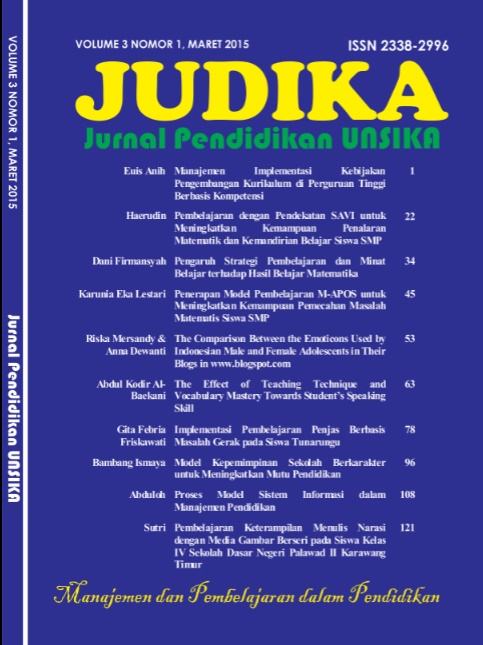THE COMPARISON BETWEEN THE EMOTICONS USED BY INDONESIAN MALE AND FEMALE ADOLESCENTS IN THEIR BLOGS IN www.blogspot.com
DOI:
https://doi.org/10.35706/judika.v3i1.201Abstract
The development of Internet language leads to the introduction of emoticons to cope with the lack of visual contacts or facial expression. Consequently, emoticons play a crucial role in Internet communication because they create more expressive messages and can be used as a means of visual communication among the users. This paper tries to identify and explain the use of emoticons by males and females. The writers conduct a study on 30 Indonesian adolescents’ blogs. The number of postings analyzed consists of 15 postings of male blogs and 15 postings of female blogs, and each posting consists of 300 until 500 words. The total number of words in the corpus is 12,539 word tokens. This study confirms that both male and female adolescents combine the use of the Western emoticons and Eastern emoticons. The data shows female adolescents use 182 emoticons, while male adolescents only use 57 emoticons in their blogs. The 182 emoticons used by the females can be categorized into five groups, they are happy, sad, angry, tired, and love. Whereas, the 57 emoticons used by the males can be classified into three groups, they are happy, angry and tired emoticons. This means that females do not only use more emoticons, but also more various emoticons than males do. Since emoticons have been interpreted as an indicator of expressiveness in the absence of paralanguage or extralinguistic cues, we can also say that female adolescents tend to be more expressive than male adolescents in online settings, particularly in their blogs.
Keywords: adolescents; blog; Eastern emoticons; emoticons; Western emoticons.
Downloads
References
Anthony, L. (2011, November 10). AntConc ( Windows, Macintosh OS X , and Linux). Retrieved July 22, 2012, from Laurence Anthony's Web site. http://www.antlab.sci.waseda.ac.jp/software.html
Cresswell, J.W. (2003). Research Design Qualitative, Quantitative , and Mixed Methods Approaches (Vol. Second edition). London: Sage Publications.
Crystal, D. (2004 ). Language and the Internet. Cambridge: Cambridge University Press.
_ _ _ _ _ _. (2006). Language and the Internet : 'Engaging & provocative' Nature (2nd edition ed.). Cambridge: Cambridge University Press.
_ _ _ _ _ _. (2011). Internet Linguistics : A student guide. New York: Routledge.
Danet, B., & Herring, S. C. (2007). The Mutilingual Internet. New York: Oxford University Press.
Edukasi kompas. (2009, March 20). Pengguna Internet Indonesia Didominasi Remaja. Retrieved May 31, 2012, from Kompas.com: http://edukasi.kompas.com/read/2009/03/20/2028042/Pengguna.Internet.Indonesia.Didominasi.Remaja.
Huffaker, D.A., and Calvert, S.L. (2005). Gender, identity, and language used in teenage blogs. Journal of Computer-Mediated Communication, 10(2), article 1. Retrieved on November 1st, 2011 from http://jcmc.indiana.edu/vol10/issue2/huffaker.html
Ip, A. (2002). The Impact of Emoticons on Affect Interpretation in Instant Messaging. Retrieved April 26, 2012, from Amysmile Web site: http://amysmile.com. (2002, December 1)
Nishimura, Y. (2003). Linguistic Innovations and Interactional Features in Japanese BBS Communication. In B. Danet, & S. C. Herring, The Multilingual Internet. New York: Oxford University Press.
Oxford. (2010). Oxford Advanced Learner’s Dictionary, New Edition. Oxford : University Press.
Roman, C. (1994). The Women and Language Debate : A Sourcebook. Piscataway: Rutgers University Press.
Sukyadi, D., Setyarini, S., & Junida, A. I. (2011). A Semiotic Analysis of Cyber Emoticons ( A case Study of Kaskus Emoticons in the Longue Forum at Kaskus-the Largest Indonesian Community). k@t@, 37.
The Jakarta Post. (2011, October 28). Internet users in Indonesia reaches 55 million people. Retrieved June 22, 2012, from The Jakarta Post Web site: http://www.thejakartapost.com/news/2011/10/28/internet-users-indonesia-reaches-55-million-people.html
Tseliga, T. (2007). "It's All Greeklish to Me !". In B. Danet, & S. C. Herring, The Multilingual Internet (p. 121). New York: Oxford University Press.
Varnhagen, et al. (2009). lol : new language and spelling in instant messaging. Springer Science+Business Media , 123.



